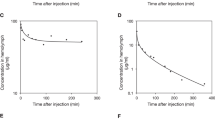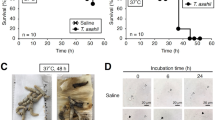Abstract
Voriconazole (VRCZ) is a triazole antifungal agent used for the treatment and prophylaxis of invasive fungal infections. Therapeutic drug monitoring of VRCZ is widely applied clinically because of the large inter-individual variability that is generally observed in VRCZ exposure. The blood levels of VRCZ are increased during an underlying inflammatory reaction, which is associated with infections. Silkworms are useful experimental animals for evaluating the pharmacokinetics and toxicity of compounds. In this study, we investigated the pharmacokinetic parameters, such as elimination half-life, clearance, and distribution volume of VRCZ using silkworms. The pharmacokinetic parameters of VRCZ were determined based on the concentrations in silkworm hemolymph after injection of VRCZ. The elimination half-life of VRCZ in silkworms was found to be similar to that observed in humans. In addition, we assessed the impact of Candida albicans infection on VRCZ concentrations in a silkworm infection model. The VRCZ concentration at 12 h after injection in the Candida albicans-infected group was significantly higher than that in the non-infected group. In the silkworm infection model, we were able to reproduce the relationship between inflammation and VRCZ blood concentrations, as observed in humans. We demonstrate that silkworms can be an effective alternative model animal for studying the pharmacokinetics of VRCZ. We also show that silkworms can be used to indicate essential infection and inflammation-based pharmacokinetic variations in VRCZ, which is usually observed in the clinic.
This is a preview of subscription content, access via your institution
Access options
Subscribe to this journal
Receive 12 print issues and online access
$259.00 per year
only $21.58 per issue
Buy this article
- Purchase on Springer Link
- Instant access to full article PDF
Prices may be subject to local taxes which are calculated during checkout




Similar content being viewed by others
References
Patterson TF, et al. Practice guidelines for the diagnosis and management of aspergillosis: 2016 update by the Infectious Diseases Society of America. Clin Infect Dis. 2016;63:e1–e60.
Mangal N, et al. Optimization of voriconazole therapy for the treatment of invasive fungal infections in adults. Clin Pharm Ther. 2018;104:957–65.
Theuretzbacher U, Ihle F, Derendorf H. Pharmacokinetic/pharmacodynamic profile of voriconazole. Clin Pharmacokinet. 2006;45:649–63.
Troke PF, Hockey HP, Hope WW. Observational study of the clinical efficacy of voriconazole and its relationship to plasma concentrations in patients. Antimicrob Agents Chemother. 2011;55:4782–8.
Hamada Y, Seto Y, Yago K, Kuroyama M. Investigation and threshold of optimum blood concentration of voriconazole: a descriptive statistical meta-analysis. J Infect Chemother. 2012;18:501–7.
Park WB, et al. The effect of therapeutic drug monitoring on safety and efficacy of voriconazole in invasive fungal infections: a randomized controlled trial. Clin Infect Dis. 2012;55:1080–7.
Dolton MJ, et al. Multicenter study of voriconazole pharmacokinetics and therapeutic drug monitoring. Antimicrob Agents Chemother. 2012;56:4793–9.
Stanke-Labesque F, Gautier-Veyret E, Chhun S, Guilhaumou R, French Society of Pharmacology and Therapeutics. Inflammation is a major regulator of drug metabolizing enzymes and transporters: consequences for the personalization of drug treatment. Pharm Ther. 2020;215:107627.
van Wanrooy MJP, et al. Inflammation is associated with voriconazole trough concentrations. Antimicrob Agents Chemother. 2014;58:7098–101.
Ventura MAE, et al. Longitudinal analysis of the effect of inflammation on voriconazole trough concentrations. Antimicrob Agents Chemother. 2016;60:2727–31.
Yasu T, et al. Serum C-reactive protein levels affect the plasma voriconazole trough levels in allogeneic hematopoietic cell transplant recipients. Leuk Lymphoma. 2017;58:2731–33.
Matsumoto Y. Facilitating drug discovery in human disease models using insects. Biol Pharm Bull. 2020;43:216–20.
Kaito C, Murakami K, Imai L, Furuta K. Animal infection models using non-mammals. Microbiol Immunol. 2020;64:585–92.
Abdelli N, Peng L, Keping C. Silkworm, Bombyx mori, as an alternative model organism in toxicological research. Environ Sci Pollut Res Int. 2018;25:35048–54.
Hamamoto H, et al. Quantitative evaluation of the therapeutic effects of antibiotics using silkworms infected with human pathogenic microorganisms. Antimicrob Agents Chemother. 2004;48:774–9.
Hamamoto H, et al. Effects of molecular mass and hydrophobicity on transport rates through non-specific pathways of the silkworm larva midgut. Int J Antimicrob Agents. 2005;26:38–42.
Matsumoto Y, et al. Quantitative evaluation of cryptococcal pathogenesis and antifungal drugs using a silkworm infection model with cryptococcus neoformans. J Appl Microbiol. 2012;112:138–46.
Hamamoto H, Horie R, Sekimizu K. Pharmacokinetics of anti-infectious reagents in silkworms. Sci Rep. 2019;9:9451.
Kaito C, Akimitsu N, Watanabe H, Sekimizu K. Silkworm larvae as an animal model of bacterial infection pathogenic to humans. Micro Pathog. 2002;32:183–90.
Hanaoka N, et al. Identification of the putative protein phosphatase gene PTC1 as a virulence-related gene using a silkworm model of Candida albicans infection. Eukaryot Cell. 2008;7:1640–8.
Matsumoto Y, Sekimizu K. Silkworm as an experimental animal for research on fungal infections. Microbiol Immunol. 2019;63:41–50.
Pan G, et al. Invertebrate host responses to microsporidia infections. Dev Comp Immunol. 2018;83:104–13.
Ishii K, et al. Porphyromonas gingivalis peptidoglycans induce excessive activation of the innate immune system in silkworm larvae. J Biol Chem. 2010;285:33338–47.
Matsumoto Y, Ishii M, Hasegawa S, Sekimizu K. Enterococcus faecalis YM0831 suppresses sucrose-induced hyperglycemia in a silkworm model and in humans. Commun Biol. 2019;2:157.
Rudramurthy SM, et al. Pharmacodynamics of voriconazole against wild-type and azole-resistant aspergillus flavus isolates in a nonneutropenic murine model of disseminated aspergillosis. Antimicrob Agents Chemother. 2016;61:e01491–16.
Azeredo FJ, et al. Does the anesthetic urethane influence the pharmacokinetics of antifungal drugs? A population pharmacokinetic investigation in rats. J Pharm Sci. 2015;104:3314–8.
Hamamoto H, Tonoike A, Narushima K, Horie R, Sekimizu K. Silkworm as a model animal to evaluate drug candidate toxicity and metabolism. Comp Biochem Physiol C Toxicol Pharm. 2009;149:334–9.
Geist MJP, et al. Steady-state pharmacokinetics and metabolism of voriconazole in patients. J Antimicrob Chemother. 2013;68:2592–9.
Roffey SJ, et al. The disposition of voriconazole in mouse, rat, rabbit, guinea pig, dog, and human. Drug Metab Dispos. 2003;31:731–41.
Warrilow AG, et al. The evolution of azole resistance in Candida albicans Sterol 14α-demethylase (CYP51) through incremental amino acid substitutions. Antimicrob Agents Chemother. 2019;63:e02586–18.
Chaluvadi MR, et al. Regulation of hepatic cytochrome P450 expression in mice with intestinal or systemic infections of citrobacter rodentium. Drug Metab Dispos. 2009;37:366–74.
Märtson AG, et al. Posaconazole trough concentrations are not influenced by inflammation: a prospective study. Int J Antimicrob Agents. 2019;53:325–9.
Naito T, Yamada T, Mino Y, Kawakami J. Impact of inflammation and concomitant glucocorticoid administration on plasma concentration of triazole antifungals in immunocompromised patients. Clin Chim Acta. 2015;441:127–32.
Acknowledgements
We thank Tae Nagamachi and Asami Yoshikawa (Meiji Pharmaceutical University) for their technical assistance in rearing the silkworms. This project was supported by JSPS KAKENHI grant number JP20K16095 (Early-Career Scientists to TY) and JP20K07022 (Scientific Research (C) to YM).
Author information
Authors and Affiliations
Corresponding authors
Ethics declarations
Conflict of interest
The authors declare no competing interests.
Additional information
Publisher’s note Springer Nature remains neutral with regard to jurisdictional claims in published maps and institutional affiliations.
Supplementary information
Rights and permissions
About this article
Cite this article
Yasu, T., Matsumoto, Y. & Sugita, T. Pharmacokinetics of voriconazole and its alteration by Candida albicans infection in silkworms. J Antibiot 74, 443–449 (2021). https://doi.org/10.1038/s41429-021-00428-z
Received:
Revised:
Accepted:
Published:
Issue Date:
DOI: https://doi.org/10.1038/s41429-021-00428-z



